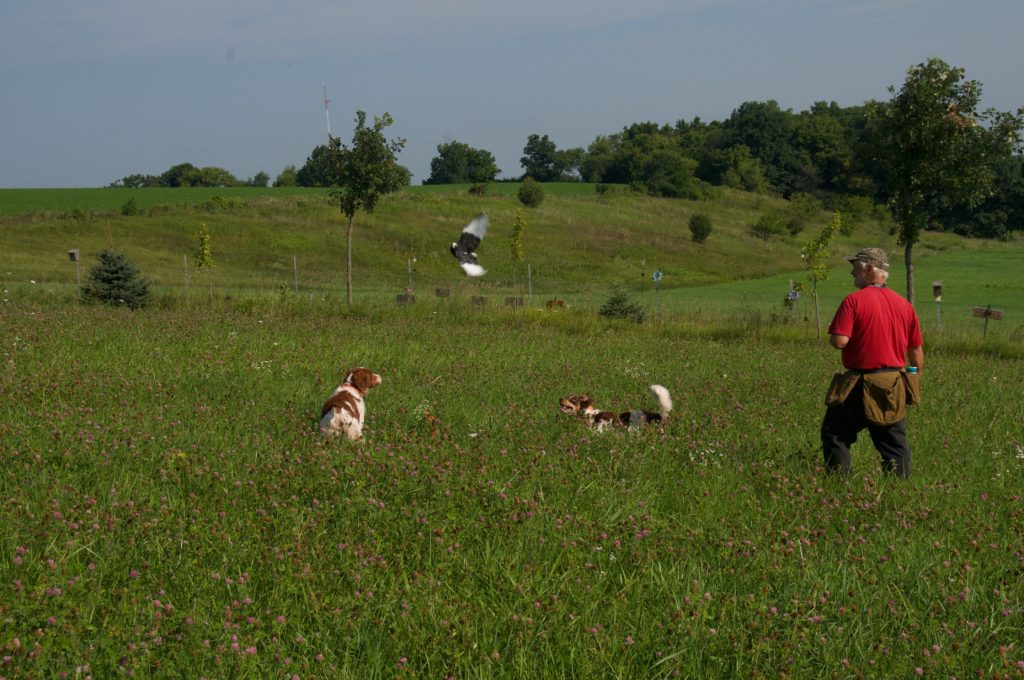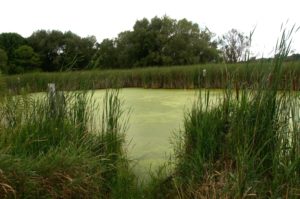
Dogs, Land, People, and Potential

When Mike Lake’s dad purchased the farm northeast of Hustisford, Wisconsin, it was considered a failing property. Its compact size included grazed woodland, marsh, pasture and a relatively small amount of cropland. But, two generations of Lakes have one thing in common–belief in potential. And not just that potential exists, but they can spot it, nurture it, and in time, realize it.
The dog kennels and pigeon cages hide discretely behind the prow of a hill on the Lake’s other property southwest of town. The buildings are well-maintained. The yard is orderly, manicured, and festooned with a wide variety of trees of varying species and ages. Clearly, these landowners love trees.
The unmistakable evidence of this affinity for trees is the 400 year-old burr oak that dominates the front yard and commands attention away from everything else along the hillside. What makes this hulking specimen even more impressive is a recent highway reconstruction project buried five feet of its trunk. Despite this tremendous insult, the big burr oak continues to thrive, producing healthy crops of acorns year after year.
A passion of the Lake family is raising and training bird dogs: specifically, Llewellyn Setters. As I pull into the driveway, Mike, my former co-worker of many years, greets me. We head behind the garage to the gate that leads back to attractive and well-maintained kennels. The walk into increasing chaos of barking and dancing paws reveals two fanatically eager Llewellyns named Buddy and Richie.
With a firm command from Mike, the seven year-old Buddy settles down, while eight month-old Richie dances, jacked-up on exuberance and anticipation well beyond the ability to hear the wishes of his master. This failure to heed instruction brings a swift and sobering rebuke from Mike, with Richie settling beside his mate … sort of, but still twitching with anticipation. Our introductions are made; their affection and curiosity are immediate and overwhelming. These boys are real people-pleasers and affectionate to the core.
This is my first visit to his farm, a twenty-one acre spread he bought from his father. A practical guy, the elder Lake purchased the farm in part because he wanted his sons to learn the lessons that the land had to teach.
The elder Lake set the boys to work clearing rocks from the pasture, turning it into relatively productive cropland. The summers spent clearing land, making hay, and tending the livestock brought the boys into communion with the land in a way their father, who worked off the farm, could never have provided for them if they had lived in town.
While I’m here get to know his property and offer some suggestions, no visit would be complete without an exhibition from the Llewellyns: they are an intricate part of the family and of the land. Pulling from the back of his pickup a utility type belt filled with training gear and what appears to be a starter’s pistol, Mike prepares for what will be a brief training exercise for his dogs and a jaw-dropping show for me.
The “hunt”

The gate to the dog pen swings open and two canine bullets explode into the backyard, circling quickly to find out which direction their master is headed. Mike makes a brief stop at the pigeon roost to open its door for the birds that will be returning soon from their morning excursion. With a turn toward the corner of the backyard, where cattle fencing is hooked, the dogs know exactly where the games are headed — and they are at the fence before Mike has completely risen from opening the doors to the roost.
The second hook on the cattle fence hits the ground as Buddy and Richie fly across the boundary and into the lush clover field. They make one quick loop and queue up next to us, ready for the games to begin. Mike releases them, and the hunt is on. They are making wide sweeps through the clover, first to our right, then crossing back to the left twenty or thirty yards ahead. It is near the end of this first sweep back that Buddy, a seasoned veteran and recently certified Master, catches the scent of the first bird.
His approach is slow, steady, and sure. This dog knows exactly what to do and how it is to be done correctly. His kennel mate Richie is still making broad sweeps of the field but, noticing Buddy coming to point, swings around to join in on the fun. Having now caught the scent for himself, Richie makes his approach on the bird. His point is bold and filled with vibrato; his back is straight, tail pointing straight up, its plume fluttering like the bright sale flags in front of a car dealership.

Buddy remains on his original point, seemingly unperturbed by this young interloper who has crept between him and the bird to steal his point. The elder knows and respects field etiquette, which requires the first dog to hold its point no matter what happens. Richie has not yet learned the rules of the game that would have brought him to a stop somewhat farther away than Buddy, performing what is called “backing” his partner on the point. This is a lesson Richie will need to learn before he can qualify in field trials and before he heads out on a live-fire hunt.
With both dogs on point, Mike clicks the remote control that opens the cage holding the target pigeon, which launches into air, all wings and cooing. Mike removes the starter’s pistol and, after a two-second delay, pulls the trigger. Though not as loud as a shotgun, the pistol shot tells the dogs to ready themselves for the command that will follow. “Get ‘em,” shouts Mike, and the dogs are off pursuing their quarry. Because this is a training exercise and the pigeon is unharmed, their pursuit will not end in a successful retrieval, but the dogs seem unaware and bound off fully expecting to find their bird.
Training ground, themselves
Over at the farm, our first stop is the field Mike and his brother cleared for cultivation decades previous. Eight years ago, the Lakes decided to enroll the field in the Conservation Reserve Program (CRP), a government set-aside program to plant fields prone to excessive erosion to permanent grass or tree cover. Mike had no problem planting over their memories of land clearing. The pursuit of potential is about the future, and the program felt right.
Currently, it’s year eight of a ten-year contract and this was their first. They were inexperienced in both restoration and government programs. Eight years ago, the Farm Service Administration (FSA) utilized CRP to primarily address soil conservation and crop production. Of additional benefit, the maintenance of permanent grass cover, including prohibitions on mowing during nesting season, supports declining populations of grassland birds. Programs can be “trained” too; recent program improvements include greater plant diversity to support declining pollinators.
Over the first six years, Mike and Dawn found out how important it is to negotiate contract terms that meet the goals of both parties. They also found out that the tasks spelled out in CRP contracts are strictly enforced. A deadline for burning came and went because of a math error in counting years. Convincing the FSA staffer that it was an innocent mistake took some work and required negotiating a get-well plan to bring the field back into compliance. While it has been a learning experience, the Lakes plan to sign another contract when the current agreement expires in two years. This time, however, they will negotiate smarter terms that give them needed flexibility, meeting their conservation goals while achieving those of CRP as well. If it’s about better outcomes, the Lakes appreciate training applies to them too.

Beyond the CRP field, a swale splits the property from southwest to northeast. The northerly end opens to an expansive marsh that extends several miles. Sedimentation did away with all its open water decades ago. Mike put in a scrape to recreate some year-round open water. Spaced around the pond are eight wood duck boxes. Each year those boxes host a new generation of the colorful waterfowl. Like a popular resort B&B, returning wood ducks seem to reserve all eight boxes early to make sure they get their prized locations.
Farther to the east, a small oak woodland once grazed, now provides a welcoming home to young basswoods. Under the increased shade of those oaks and basswoods, maple seedlings are continuing the succession brought about by the deepening shade. Without openings in the dense canopy, oak is forever in the rearview mirror-a decision-point for sure and probably best navigated with the help of a forester. So too, the cover of shade has welcomed nefarious dwellers.
Around the woodland edges are the all too common scourges of southern Wisconsin woodlands: buckthorn and honeysuckle. Currently, there are relatively few large seed bearing shrubs. However, buckthorn seedlings are beginning to create a collar around the edges and have begun to push into the interior to the woodland.
We discuss treatment options. Mike wanted to use Tordon (active ingredient is picloram), a direct mix stump treatment herbicide. I pointed out that Tordon is a restricted use pesticide, meaning it should only be applied by someone with a DATCP Pesticide Applicator’s License. Importantly, it easily escapes the roots of a treated stump, moving through the soil and killing trees you want to save. Finally, Tordon is water based; it freezes, preventing it from being used in the winter when woodlands are more accessible and brush piles can be burned without fear of sparking a wildfire.

I suggested Garlon 4 (active ingredient is triclopyr) instead. Garlon 4 is an oil-based herbicide, so it will not freeze. It does not escape roots or easily move through the soil. Also, Garlon 4 does not require a pesticide applicator’s license.
We settled on brush cutting the seedlings every year or two to keep them in check using a brush saw. They will use a chainsaw to cut down the mature shrubs and apply cut-stump strength Garlon 4 to prevent the shrubs from re-sprouting.
As we wrap up our walk, I recommend that Mike walk his woods with his County Forester. It’s a free property visit offered through the Forestry Division of the Wisconsin Department of Natural Resources. A County Forester can help Mike and Dawn decide which trees they want to encourage in their woodland and which might make management more difficult for them. Mike likes the idea, but then again, it’s always about discovering and realizing potential.
Written by Mark Horn, Conservation Digest
